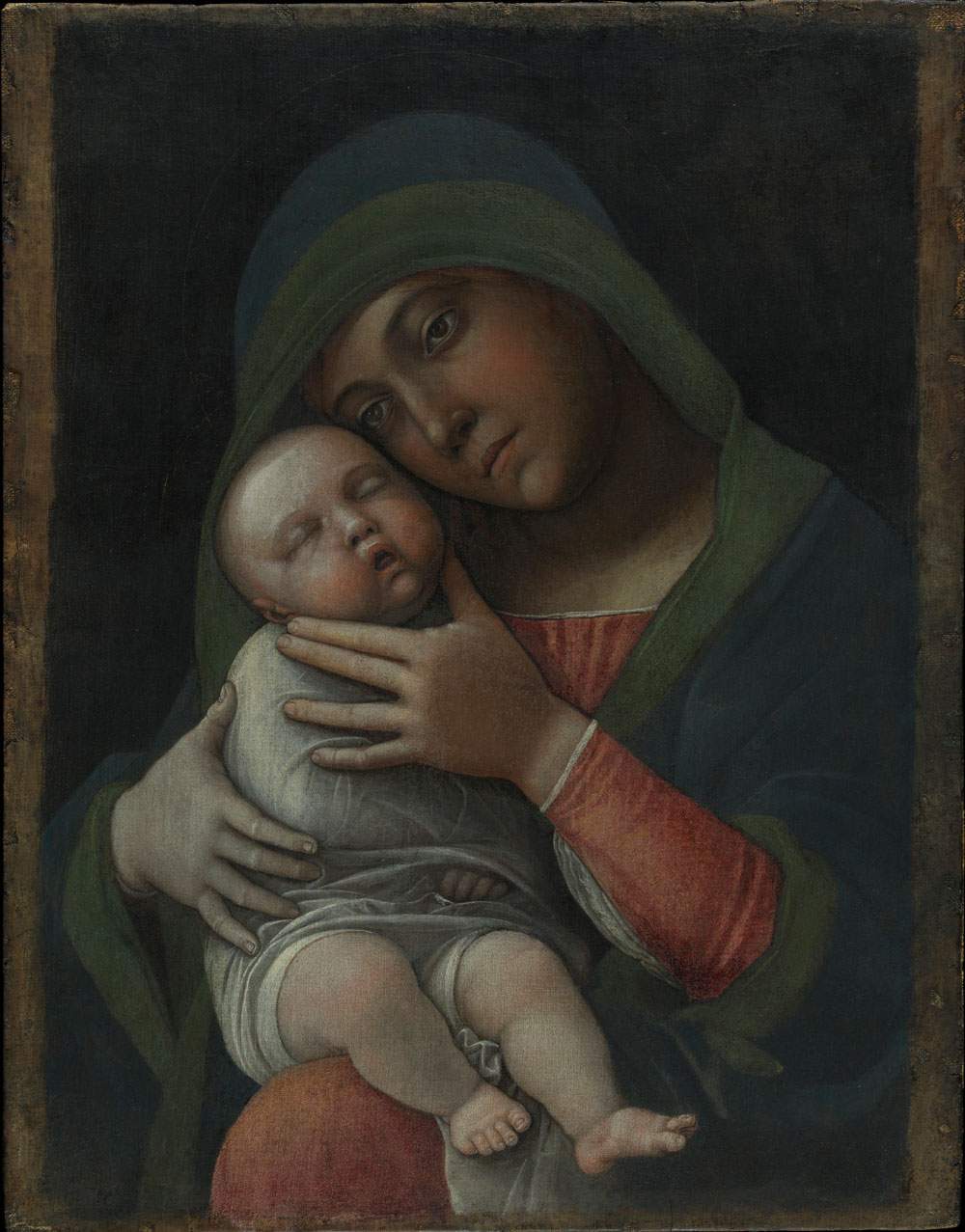The rediscovered Mantegna. At the Poldi Pezzoli Museum the exhibition-dossier on the restoration
The Poldi Pezzoli Museum presents from October 15 the exhibition-dossier Mantegna ritrovato, dedicated to the restoration of Andrea Mantegna’s Madonna and Child. The exhibition is curated by the museum house and theOpificio delle Pietre Dure of Florence and is set up in the Salone dell’Affresco: the various phases of the conservation intervention and the vicissitudes of the collection will be recounted on this occasion. The restoration was carried out by Lucia Bresci, under the direction of Cecilia Frosinini of the Opificio delle Pietre Dure, in collaboration with Andrea Di Lorenzo, curator of the Poldi Pezzoli Museum. Fundamental was the support of the Giulio and Giovanna Sacchetti Onlus Foundation.
The exhibition-dossier is divided into two rooms: the first introductory with the presence of explanatory panels; the second presents Mantegna’s work alone, with the room left bare. A curtain isolates the masterpiece from the rest of the museum so that the view and attention are focused only on the work. The installation was made by Unifor, designed by Luca Rolla and Alberto Bertini.
“The restoration of the masterpiece,” said Annalisa Zanni, director of the Poldi Pezzoli Museum, “has been a long team effort, also thanks to the Museum’s Restoration Club, which has seen restorers, art historians, but also philosophers, debating at length on the methods of intervention to be carried out in order to restore to the work the identity given to it by its creator, before Giuseppe Molteni’s interventions that had made it different but certainly loved and recognizable to all, a true ’pop icon’. This would not have been possible without the recognized professionalism of the Opificio delle Pietre Dure in Florence and the sensitivity of Marchesa Giovanna Sacchetti, a generous and attentive patron.”
“My Foundation has been involved for years in bringing to light the beauty of our artistic heritage, supporting prestigious institutions such as the Poldi Pezzoli Museum,” stressed Marchesa Giovanna Sacchetti, president of the Giulio and Giovanna Sacchetti Onlus Foundation. When the restoration of Andrea Mantegna’s Madonna and Child was proposed to me, I accepted with great pleasure also because of my 40-year relationship of esteem and friendship with Dr. Annalisa Zanni. During these months I have been involved in all the evolutions of the restoration up to the discovery that led to this “rediscovered masterpiece.” Mantegna’s beauty is beyond question, but what we see today is like a new birth, for a work that I hope will be studied with increasing interest by experts and appreciated by the museum public."
The painting had been restored by Giuseppe Molteni, director of the Pinacoteca di Brera as well as a portrait painter and friend of the Poldi Pezzoli family, in the 19th century, and its appearance had been altered to such an extent that it was difficult to judge. In fact, the work had been attributed to the most varied phases of Mantegna’s activity: from his youthful period in Padua to the beginning of his stay in Mantua, which took place between 1462 and 1470, to his late activity in the last decade of the fifteenth century. The latter opinion has prevailed in recent years. Molteni was known for his integrative interventions, which claimed to improve the aesthetic appearance of ancient paintings according to the academic taste in force at the time. Now, thanks to the current restoration, it is possible to make a more confident judgment on the work, which can be dated to the early 1590s.
TheOpificio delle Pietre Dure began the conservation work in March 2019, starting with athorough diagnostic campaign. The diagnostic analysis was also necessary to understand the execution technique, the conservation status of the painting, to more accurately define the extent of Molteni’s intervention, and to clarify some small discoveries that were being revealed. In particular, in correspondence with the Virgin’s mantle, the investigations revealed a double pictorial version: a drafting in Prussian Blue, characterized by a drapery of typically 19th-century taste, attributable to Molteni’s hand; and, below this, a still very intact drafting in Azurite, in which the original pictorial version was recognized. The rich gilded motif decorating the red robe was also almost entirely to be attributed to Molteni: the brushstrokes of gold in shell possessed an excessively painterly character and followed patterns of reconstructive fantasy. Finally, the mastic varnish, with which the restorer intended to protect the pictorial layers, had profoundly altered the work, making it aesthetically similar to an oil painting and hiding the peculiarities of the particular execution technique of lean tempera used by Mantegna. The restoration intervention has therefore re-established a formal balance, through the gradual removal of the varnish that altered the original appearance of the work: originally, the painting was in fact characterized by an opaque and almost pulverulent effect of the surface, in imitation of banners or wall painting. “With this restoration,” pointed out Marco Ciatti, Superintendent of the Opificio delle Pietre Dure and Restoration Laboratories, “the Opificio delle Pietre Dure has won a real technical challenge that can also open the possibility for other recoveries of masterpieces altered by old restorations, and has allowed for the reading of the correct expressive values that Andrea Mantegna had included in this small but precious painting.”
Hours: Wednesday through Monday from 10 a.m. to 1 p.m. and 2 to 6 p.m.
Tickets: Full 10 euros, reduced 7 euros.
Image: Andrea Mantegna, Madonna and Child (1490-1499; lean tempera on canvas, 35.5 x 45.5 cm; Milan, Museo Poldi Pezzoli)
 |
| The rediscovered Mantegna. At the Poldi Pezzoli Museum the exhibition-dossier on the restoration |
Warning: the translation into English of the original Italian article was created using automatic tools. We undertake to review all articles, but we do not guarantee the total absence of inaccuracies in the translation due to the program. You can find the original by clicking on the ITA button. If you find any mistake,please contact us.




























